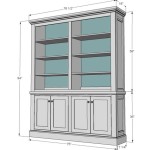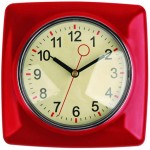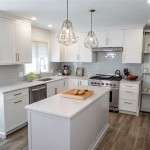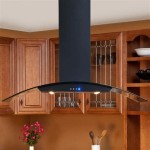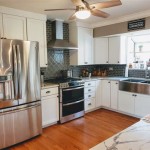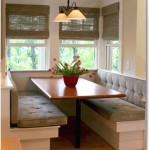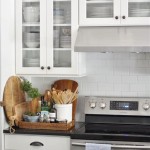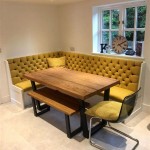Can You Mix Knobs and Pulls on Kitchen Cabinets? Exploring Design Flexibility
The question of whether to mix knobs and pulls on kitchen cabinets is a common one for homeowners embarking on a kitchen renovation or simply looking to update their existing cabinetry. There is no single "right" answer, as the decision depends on a variety of factors, including personal preference, kitchen style, cabinet layout, and functionality. A well-thought-out combination of knobs and pulls can enhance the overall aesthetic and improve the usability of the kitchen, while a mismatched approach can detract from the design.
Traditionally, kitchens often featured either all knobs or all pulls on cabinet doors and drawers. However, contemporary design trends embrace a more eclectic and personalized approach, opening the door to mixing hardware styles. This approach allows for greater flexibility in achieving a unique and visually appealing kitchen design. It also provides an opportunity to tailor hardware choices to the specific function of each cabinet or drawer.
Mixing knobs and pulls is not simply about arbitrarily selecting different hardware. It requires careful consideration and a cohesive design plan to ensure a harmonious and functional outcome. Understanding the principles of design, the different types of hardware available, and the specific needs of the kitchen are essential for a successful implementation of this trend.
Understanding the Aesthetic Considerations
The aesthetic impact of mixing knobs and pulls is perhaps the most significant aspect to consider. The choice of hardware significantly influences the overall style and feel of the kitchen. Therefore, it is crucial to ensure that the selected knobs and pulls complement each other and the existing kitchen design. Factors to consider include finish, style, and size.
The finish of the hardware should be consistent throughout the kitchen. Mixing different finishes, such as brushed nickel with oil-rubbed bronze, can create a disjointed and uncoordinated look. It is generally advisable to stick with a single finish family, even if the specific shades vary slightly. For example, different shades of brass or different textures of nickel can add visual interest without sacrificing cohesion.
The style of the knobs and pulls should also be complementary. Mixing modern, minimalist knobs with ornate, traditional pulls can create a clash in styles. Instead, aim for a consistent style theme, such as pairing streamlined knobs with equally sleek pulls for a contemporary kitchen, or opting for more rustic or vintage options for a traditional space. The key is to ensure that the shapes and detailing of the knobs and pulls work harmoniously together.
The size of the hardware should be proportionate to the size of the cabinets and drawers. Overly small knobs on large drawers can look underwhelming, while oversized pulls on small cabinets can appear clunky. A general rule of thumb is to choose hardware that is approximately one-third of the width of the drawer or door. This guideline provides a balanced and visually appealing proportion.
Considering the overall color scheme of the kitchen is also important. Hardware can be used to either blend in with the cabinetry or provide a contrasting accent. For example, dark hardware on light cabinets creates a striking contrast, while light hardware on light cabinets offers a more subtle and understated look. The color of the hardware should complement the other elements of the kitchen, such as the countertops, backsplash, and appliances.
Functional Considerations in Hardware Selection
Beyond aesthetics, the functional aspects of knobs and pulls are equally important. The primary purpose of cabinet hardware is to provide a comfortable and secure grip for opening and closing doors and drawers. The choice between knobs and pulls can impact the ease of use and accessibility of the cabinets.
Pulls generally offer a more substantial grip and can be easier to use for opening heavier drawers or cabinets. They distribute the pulling force more evenly, reducing strain on the hinges and drawer glides. This is particularly beneficial for drawers that contain frequently used items, such as pots and pans, or for cabinets that are heavily loaded.
Knobs, on the other hand, require a more precise grip and may be less comfortable for individuals with arthritis or limited hand strength. They are often best suited for lighter cabinets or drawers that are not frequently used. Knobs can also be a more economical option, as they are typically less expensive than pulls.
When mixing knobs and pulls, it's a common practice to use pulls on drawers and knobs on doors. This approach aligns the hardware choice with the function of the cabinet. Drawers, which are typically heavier and require more force to open, benefit from the ergonomic advantage of pulls. Doors, which are generally lighter, can be easily opened with knobs. This combination can provide a balance between aesthetics and functionality.
Accessibility is another important functional consideration. If the kitchen is used by individuals with mobility limitations, pulls may be a better choice for all cabinets and drawers, as they offer a more secure and comfortable grip. Longer pulls can be especially helpful for individuals with limited reach. The hardware should also be installed at a height that is easily accessible for all users.
The placement of the hardware is also crucial for functionality. Knobs are typically installed in the center of the door or drawer, while pulls can be installed horizontally or vertically, depending on the orientation of the cabinet or drawer. The placement should ensure that the hardware is easily accessible and provides a comfortable grip. It is advisable to test the placement of the hardware before permanently installing it to ensure that it is ergonomically sound.
Strategies for Successfully Mixing Knobs and Pulls
Successfully mixing knobs and pulls requires a strategic approach that considers both aesthetic and functional factors. There are several strategies that can help to create a cohesive and functional kitchen design.
One common strategy is to use pulls on all drawers and knobs on all doors. This approach provides a clear distinction between the function of the hardware and can create a visually balanced look. It also offers the ergonomic benefits of pulls for accessing drawers, which are typically heavier and require more force to open.
Another strategy is to use pulls on wider drawers and knobs on narrower drawers and doors. This approach considers the size and weight of the drawer. Wider drawers, which are typically heavier, benefit from the added leverage provided by pulls. Narrower drawers and doors can be easily opened with knobs.
A third strategy is to use pulls on base cabinets and knobs on upper cabinets. This approach can help to visually differentiate the upper and lower cabinetry. It also provides the ergonomic benefits of pulls for accessing base cabinets, which are often located lower to the ground and may be harder to reach. Knobs on upper cabinets can be easily accessed and provide a more streamlined look.
Within each of these strategies, it is important to maintain consistency in finish, style, and size. The hardware should be chosen to complement the overall style and color scheme of the kitchen. The knobs and pulls should also be proportionate to the size of the cabinets and drawers. It is also a good idea to maintain a consistent distance between the screw holes. That way, if you ever decide to replace the hardware, you won't have to drill new holes.
Ultimately, the best approach for mixing knobs and pulls is the one that best meets the specific needs and preferences of the homeowner. Experimentation and careful planning are key to achieving a successful and visually appealing outcome. Consulting with a kitchen designer or hardware specialist can also provide valuable insights and guidance.
In summary, mixing knobs and pulls on kitchen cabinets is a viable design option that can enhance both the aesthetic appeal and functionality of the kitchen. It requires careful consideration of factors such as finish, style, size, function, and accessibility. By following these guidelines, homeowners can create a kitchen design that is both beautiful and practical.

How To Mix And Match Your Kitchen Cabinet Hardware

Top Tips For Mixing And Matching Kitchen Cabinet Hardware

How To Mix And Match Your Kitchen Cabinet Hardware

How To Mix And Match Your Kitchen Cabinet Hardware

How To Mix And Match Your Kitchen Cabinet Hardware

How To Mix Match Kitchen Hardware Finishes Styles The Inspired Room

How To Mix Match Kitchen Hardware Finishes Styles The Inspired Room

How To Mix And Match Cabinet Hardware Sprucing Up Mamahood

How To Mix Cabinet Hardware Mockett

3 Tips For Mixing Knobs Pulls On Kitchen Cabinets
Related Posts

